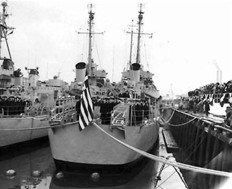The Navy says it never happened. Sailors who served on the ship in question say it never happened. Even some investigators once intrigued by the decades-old story eventually came to the conclusion that it never happened.
And yet debate over what was unimaginatively dubbed The Philadelphia Experiment rages on. Marshall Barnes stands somewhere near the center of it, insisting that the U.S. Navy could very well have done exactly what the hotly contested legend states — make a ship disappear. His research, and his battles with critics he describes as misinformants, are what he plans to talk about when he visits Philadelphia this weekend.
In 1943, the since-decommissioned Philadelphia Naval Shipyard was still an important facility — and, according to the story, the site of one of the most bizarre tests in military history. Supposedly the USS Eldridge, a destroyer escort, was made to vanish from sight, the impression of its hull in the water the only evidence that it was still there.
“Twenty minutes later, the Eldridge reappeared,” according to an article on one of the many Philadelphia Experiment Web sites, Quest for Truth: The Philadelphia Experiment. “Her crew, some of them staggering and speaking gibberish, was debriefed. They said that they could see each other but the ship was ‘gone.’ Some of the men said others were falling to the deck and laughing hysterically, ‘as if drunk.’ Others said that for a brief while after the cloud [that surrounded the ship at the start of the test] ‘flashed off’ they could see their second port, the Norfolk Naval Shipyards, and when the cloud reappeared and ‘flashed off’ again, they were back in Philadelphia.”
A second test, also involving the Eldridge, is said to have ended with disastrous results. Most of the crew members met horrific fates: Some caught fire, others became embedded in the deck when the ship rematerialized and a few seemed to waver between the physical world and some other, as if stuck in the transition. One disappeared altogether.
The Navy’s Office of Naval Research (ONR) denies all of it. A statement posted online — in response to the endless stream of inquiries — traces the story to the 1950s, when a man named Carlos Miguel Allende told a writer and, separately, two naval officers, that he’d witnessed the experiments. ONR also suggests that the story’s origins could lie in misinterpretation of real attempts in the early 1940s to demagnetize the hulls of ships, thereby making them “invisible” to the Germans’ magnetic mines.
And in March of this year, sailors who’d served on the Eldridge reunited for the first time and told an Inquirer reporter that they find the story amusing — especially because the ship never docked in Philadelphia.
But Marshall Barnes isn’t buying it. A self-described Special Civilian Investigator, Barnes has been studying The Philadelphia Experiment for years. In fact, he claims that by working with details outlined in the 1979 book The Philadelphia Experiment: Project Invisibility, he has been able to demonstrate that optical invisibility is possible.
How, you ask? Through “the use of an intense electromagnetic field that would create a mirage effect of invisibility by refracting light.” Of course, showing how it’s done would be easier than explaining, and that’s exactly what Barnes says he did earlier this year for the producers of A&E’s The Unexplained. But, as he says happened in 1996 with a similar show, Sightings, most of Barnes’ footage — including all of his demonstration, and the facts that he says refute the Navy’s assertion that it knows of no scientific basis for invisibility — was left out of the show.
His battle with the show’s producers, and his efforts to discredit what he sees as their discrediting of him, is the subject of another online article, “The Philadelphia Experiment: What They Didn’t Want You To Know”
Apparently there’s quite a bit of infighting among those who have researched The Philadelphia Experiment; in this article, Barnes skewers a number of others. He even alleges that one organization, the Society for Scientific Exploration, has been infiltrated by a shadowy group of ex-feds called The Aviary who specialize in disinformation. That’s why the society published an article refuting the Experiment, Barnes suggests.
Barnes is scheduled to visit the area on Aug. 22, as part of the three-day UFO Phenomena Conference organized by CIRAEP (Council of Investigation and Research on Aerial/Earth Phenomena). That is, assuming he hasn’t disappeared. After pitching the story, he failed to make himself available for an interview before press time.
The CIRAEP conference starts Aug. 20, at Elkins Park Hospital in Elkins Park, PA. Call 215-659-3673 for more information.

